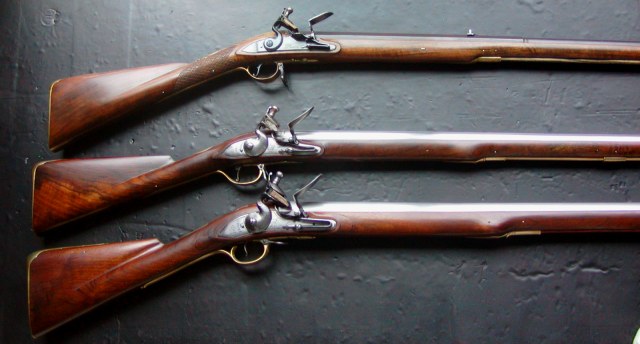Hi everyone,
I was wondering if anyone knows of any sources for examples of early British Land Pattern Musketoons from the 1720's through 1750's? I am trying to locate some examples for reference for a potential project. I am looking to see if anyone knows of any genuine examples of these that were actually manufactured during this time. If anyone could point me to any books or websites, or an extant examples I would really appreciate it. I know they made some shorter Besses later on, but I am specifically looking for earlier examples.
Thanks so much!
Tacksman
Back to what I think may be your area of interest, as you used the adjectives "Land Pattern" in your question.
I'm still not sure if you are talking about a shortened Land Pattern Bess in Musket Bore of .76 cal. (that actually varied from .76-.78 caliber as originally made) OR if you mean what for all intents and purposes looks like a scaled down Land Pattern Bess, but is of what British Ordnance began to settle as the "Carbine Bore" of .65 cal. in the later half of the 1750's and more or less commonly called that from the 1760's onward. Up to that time, they used the term "Carbine" more from the length of the barrel and not so much the caliber.
For example and it may seem strange to us, the Pattern 1744 Carbine for Dragoons was supposed to be of "Musket Bore of .76" and
the only reason they called it a "Carbine" was the barrel was "only" 42" in length compared to the normal Musket Barrel length of 46". Here are the specifications from the Royal Armouries:
Flintlock muzzle-loading musket - Pattern 1744 Dragoon (dated 1747) - Royal Armouries collections
This link shows one made to that general Pattern.
Light Dragoon Carbine – Works – The Colonial Williamsburg Foundation (history.org)
To further confuse the issue, some of them were in the slightly smaller bore size of .70 and with only a 37 1/2 inch barrel length.
Dragoon Carbine – Works – The Colonial Williamsburg Foundation (history.org)
Here is a VERY SHORT barreled Carbine in the time period you are asking about, but still in Musket Bore. Please note is has NO entry thimble, so it is not a "cut down" Long Land Pattern Musket and actually made that way when new.
Cavalry Carbine – Works – The Colonial Williamsburg Foundation (history.org)
Now if you are interested in a true Carbine Bore of .65 cal. (which often actually ran from .64-.66 cal.) that was used here in the period you mentioned, then there's the P 1744 "Carbine for Horse" or Cavalry Carbine with a 37 inch barrel. These had the early banana shaped locks and a sliding ring bar for a cavalry sling.
However, some of these were modified and became the P1748 Carbine. Bailey notes that in 1748, some P1744 Carbines were modified for Infantry by cutting the stocks back for the bayonet, soldering a new sight, taking off the sling bar attachment and filling in the stock as needed, then adding "standard" Infantry Sling Swivels. I believe these were the Carbines that the 42nd Royal Highland Regiment was armed with when they got here early in the FIW.
Then there was there was the P1756 Carbine that made it here in quantity during the FIW primarily with Highland Regiments, but to a lesser extent with Artillery and issued to some Serjeants. It had the new P1755 flatter bottom, double bridle lock, Carbine bore of .65, 37 inch barrel length and perhaps of special note, was the first and really only arm here in quantity that was made for the new Iron/Steel Rammer.
I don't know if you would like information on use of "cut down" muskets for your project?
OK, I hope this helps, but you will need to respond if it doesn't meet your needs for your project
Gus















